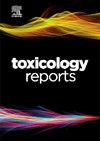核蛋白1的诱导是大鼠苯巴比妥诱导的增殖反应的早期事件,而不是人类肝脏3D显微组织
Q1 Environmental Science
引用次数: 0
摘要
组成型雄甾受体激活剂如苯巴比妥(PB)引起的大鼠(而非人类)肝癌发生过程中的一个关键事件是肝细胞增殖,但支持这种反应的机制尚不完全清楚。先前我们发现,大鼠肝微组织(LiMTs)可以重现pb诱导的肝细胞增殖反应(1)。在这项后续研究中,我们利用我们的微tma技术结合转录组学和免疫荧光(IF)染色来阐明该模型中大鼠肝癌的发生机制。我们对对照和pb处理的LiMT的激光微解剖肝组织microTMA FFPE切片生成的转录组学数据进行了基因集富集分析(GSEA),发现前者在大鼠中显著(q<0.25)富集,而在人类LiMT差异表达的基因列表中不富集。该过程还发现细胞增殖基因核磷蛋白1 (NPM1)在大鼠中被显著诱导(p <; 0.05),而在人类LiMTs中没有。平行microTMA FFPE切片IF染色结合定量图像分析证实,PB处理24和48小时后,大鼠肝脏组织中诱导了NPM1蛋白,而人肝脏组织中没有诱导NPM1蛋白。总之,我们已经确定诱导核NPM1表达是pb诱导的大鼠肝细胞增殖的早期事件。本文章由计算机程序翻译,如有差异,请以英文原文为准。
Nucleophosmin 1 induction is an early event in a Phenobarbital induced proliferation response in rat but not human liver 3D microtissues
A key event in the process of rat but not human liver carcinogenesis caused by constitutive androstane receptor activators such as phenobarbital (PB) is hepatocyte proliferation, but the mechanism(s) underpinning this response is not fully understood. Previously we showed that rat liver microtissues (LiMTs) can recapitulate a PB-induced hepatocyte proliferation response (1). In this follow up study we used our microTMA technology coupled with transcriptomics and immunofluorescence (IF) staining to elucidate mechanisms of rat liver carcinogenesis in this model. We performed gene set enrichment analysis (GSEA) on transcriptomics data generated from laser microdissected liver microtissue microTMA FFPE sections from control and PB-treated LiMTs against custom liver cell proliferation and constitutive androstane receptor (CAR) activation signatures (2) and found that the former signature was significantly (q<0.25) enriched in rat but not human LiMT differentially expressed gene lists. This process also identified the cell proliferation gene nucleophosmin 1 (NPM1) as being significantly induced (p < 0.05) in rat but not human LiMTs. IF staining of parallel microTMA FFPE sections coupled with quantitative image analysis confirmed that the NPM1 protein was induced by PB treatment in rat but not human liver microtissues after 24 and 48 hrs PB treatment. In conclusion we have identified induction of nuclear NPM1 expression as an early event in PB-induced rat hepatocyte cell proliferation.
求助全文
通过发布文献求助,成功后即可免费获取论文全文。
去求助
来源期刊

Toxicology Reports
Environmental Science-Health, Toxicology and Mutagenesis
CiteScore
7.60
自引率
0.00%
发文量
228
审稿时长
11 weeks
 求助内容:
求助内容: 应助结果提醒方式:
应助结果提醒方式:


